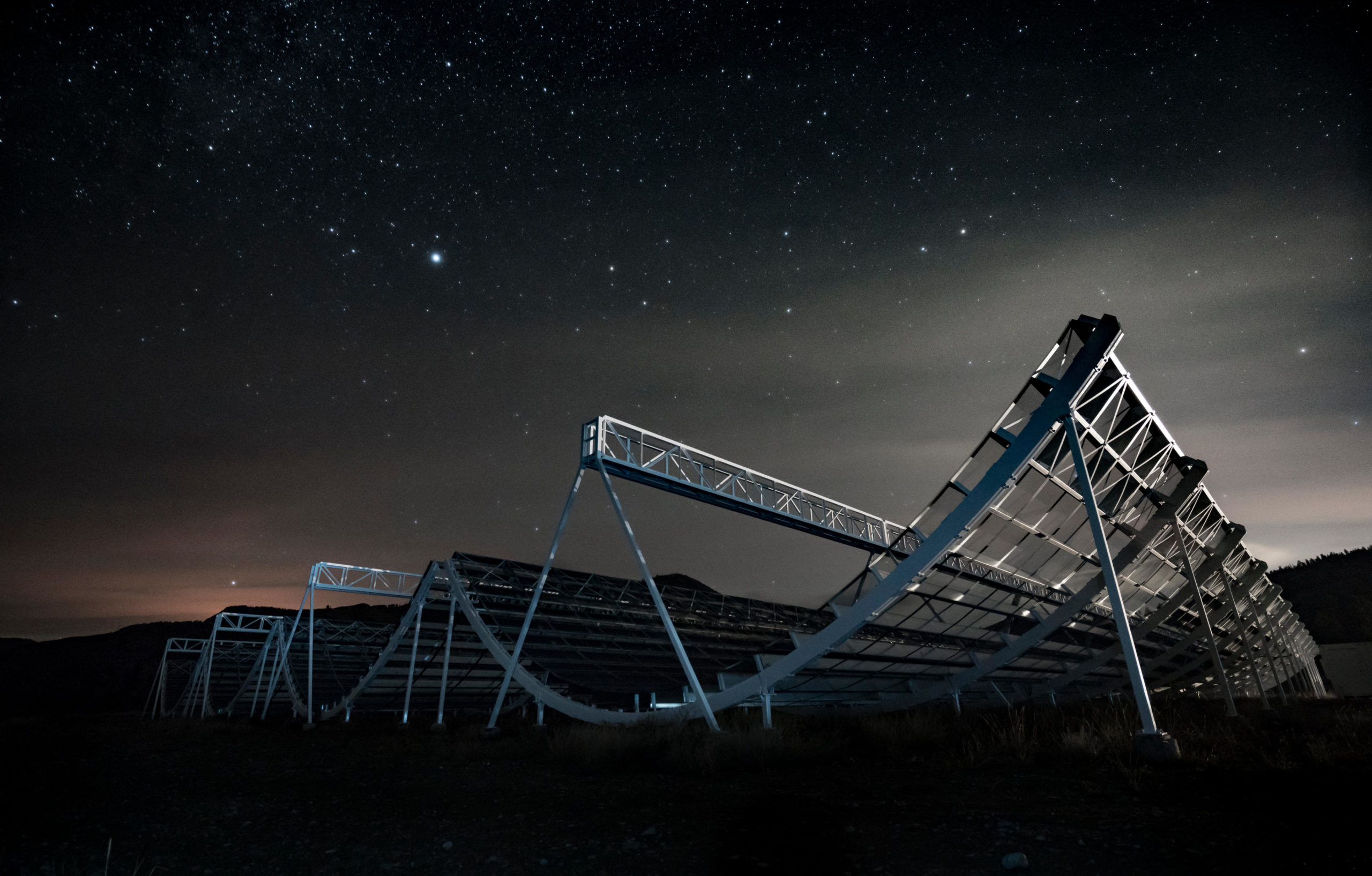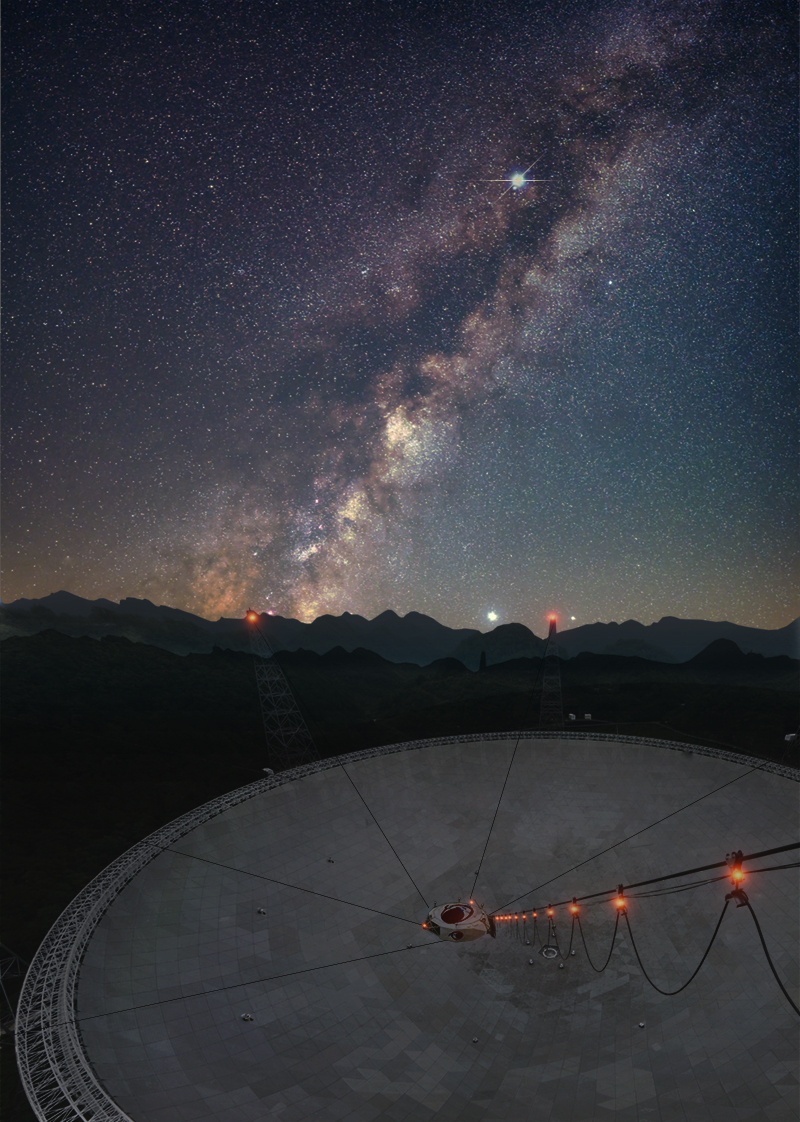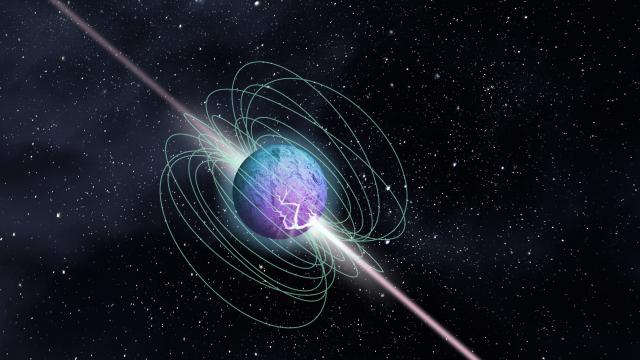For the first time ever, astronomers have linked an actual object to those mysterious radio bursts they’ve been detecting since 2007. The culprit in this case, as suspected, is a super-dense object known as a magnetar, but the finding has prompted an entirely new set of questions.
In recent years, scientists have detected hundreds of powerful, millisecond-long pulses known as Fast Radio Bursts (FRBs), all of them emanating from outside our galaxy. But on April 28, 2020 something incredible happened: astrophysicists picked up an FRB from inside the Milky Way, an event that elicited much excitement and conversation.
This particular burst, named FRB 200428, appeared to originate from a highly magnetic neutron star known as magnetar SGR 1935+2154. That the two might be connected was deemed a distinct possibility at the time, and after collecting, inspecting, cross-referencing, and correcting all the available astronomical data, three independent teams of scientists have now confirmed this to be the case. Magnetars, as these three new Nature papers conclude, are one possible source of FRBs.
Up until this point, “there has been no observational evidence directly linking FRBs with magnetars,” wrote Amanda Weltman and Anthony Walters, both astrophysicists at the University of Cape Town, in an accompanying News and Views article. “The detection reported in the three new papers offers the first such evidence, thereby providing vital clues that will help us understand the origins of at least some FRBs,” according to the pair, who weren’t involved in the new research.
The confirmation was possible thanks to international cooperation and the pooling together of data collected by multiple observatories, some on the ground and some in space. And because the galactic FRB coincided with bursts of gamma rays and X-rays, astrophysicists have acquired an important new clue in their quest to learn more about this strange celestial phenomenon.
At first, scientists thought these bright pulses of radio waves were one-time events, but some were found to repeat. This meant that FRBs, or at least some FRBs, weren’t the product of catastrophic events. Still, some of the favoured sources of these bursts included neutron stars, supernova explosions, or unknown interactions with black holes. That FRBs exclusively came from sources outside our galaxy was a serious limitation, as they travelled from so far away. Hence the importance of FRB 200428.
“So far, all of the FRBs that telescopes…have picked up were in other galaxies, which makes them quite hard to study in great detail,” explained Ziggy Pleunis, a senior PhD student at McGill University in Montreal and a co-author of the new study produced by the CHIME (Canadian Hydrogen Intensity Mapping Experiment) collaboration.

This story starts on April 27 — the day before the galactic FRB. Two space telescopes, the Neil Gehrels Swift Observatory and the Fermi Gamma-ray Space Telescope, picked up multiple bursts, in both X-rays and gamma rays, coming from the direction of magnetar SGR 1935+2154.
The following day brought the good stuff, when astronomers at CHIME detected the bright radio pulse. The CHIME observatory is located in the Canadian province of British Columbia and consists of 100 parabolic reflectors.
The very same day, scientists with STARE2 (Survey for Transient Astronomical Radio Emission 2), caught the same thing. STARE2 consists of three stations situated in the U.S. southwest.
At a press conference held on Monday, Christopher Bochenek, an astrophysicist with STARE2 and the first author of his team’s paper on the finding, said he was “paralysed with excitement” when he first saw the data. The burst was so strong, he said, that it could’ve been detected by a cell phone tuned into the right frequency at the right time. More specifically, the amount of radio energy packed into this single bright pulse is equal to the amount of radio energy produced by the Sun every 30 seconds, said Bochenek, a researcher at the California Institute of Technology.
There was an odd data discrepancy, however, as the signal received by STARE2 was 1,000 times brighter than the signal received by CHIME. The two groups investigated the disparity, finding that a calibration problem at CHIME was to blame. Once corrected for, the CHIME data matched the STARE2 observations, highlighting the importance of collecting astronomical data from multiple sources. Both teams independently concluded that FRB 200428 originated from magnetar SGR 1935+2154, which is located 30,000 light-years away.
As Bochenek pointed out, CHIME recorded two discrete bursts separated by 30 milliseconds, whereas STARE2 saw only one, but this is to be expected, given differences in the systems. Thanks to CHIME, “we know where it was coming from,” and thanks to STARE2, “we knew how bright it was,” he said. Taken together, this is now “the first FRB that comes from a known object, ” said Bochenek.
Three space telescopes also picked up X-ray signals coming from the magnetar during the burst, namely ESA’s INTEGRAL space telescope, China’s Insight space telescope, and Russia’s Konus instrument aboard NASA’s WIND satellite. So, in total, five different observatories captured the event in some form.

Also on April 28, the same patch of sky was scanned by China’s Five-hundred metre Aperture Spherical Telescope (FAST), but not at the exact time that FRB 200428 appeared. Data collected during the same day, however, showed that the magnetar had become quite active, emitting 29 soft gamma repeaters — large bursts of gamma rays and X-rays — during a 30-minute tantrum. No FRBs were detected during this outburst phase, offering tantalising new clues into the nature and circumstances associated with fast radio bursts. Details of these observations were published in a paper led by Bing Zhang from the University of Nevada in Las Vegas. Zhang also co-authored a fourth paper in this set, dealing with the possible physical mechanisms behind FRBs.
As Weltman and Walters explained in their News and Views article, FRB 200428 is the “first FRB for which emissions other than radio waves have been detected, the first to be found in the Milky Way, and the first to be associated with a magnetar.” Also, it’s the “brightest radio burst from a Galactic magnetar that has been measured so far.” And because FRB 200428 is the first galactic radio burst that’s as bright as those coming in from nearby galaxies, it “also provides much needed evidence that magnetars could be the sources of extragalactic FRBs.”
Zhang, speaking at the press conference, said he previously wasn’t optimistic about astronomers finding a source of FRBs, as a “smoking gun” seemed unlikely. But this discovery, “right in our backyard,” shows they come from magnetars, he said, adding that magnetars can explain some and possibly all FRBs observed in the universe, “but there could be more than one progenitor.”
Indeed, some very important questions remain. It’s not clear, for example, if magnetars are the only source of FRBs and if other celestial phenomena can likewise produce pulses with the same characteristics. And as Bochenek pointed out, it will be “important to nail down how often these things happen in the universe.”
Moreover, astrophysicists will now have to figure out how magnetars are capable of producing these powerful, short bursts of energy. Going theories include magnetar flares smashing into the surrounding medium, causing a shockwave, or cracks forming on the surface of super-dense neutron stars. On that last point, and though hard to believe, FRBs might actually be connected to neutron starquakes.
Finally, there’s the issue of one-offs and repeaters. The FRB observed in the Milky Way doesn’t appear to be a repeater, which “suggests there’s a difference” and that “something else is going on,” said Bochenek. At the press conference, astrophysicist Daniele Michille, a co-author of the CHIME paper, said different possible classes of sources of FRBs are possible. Zhang has a feeling that one-offs probably are repeaters, it’s just that we’re not able to detect all the bursts. Magnetars, as he pointed out, don’t die after emitting FRBs. At the same time, however, a mergers of neutron stars could account for a one-off event, or a neutron star merging with a black hole — both of which could conceivably produce FRBs and also result in the destruction of the source. But only a small proportion of FRBs are likely to be catastrophic in nature, and hence one-time events, according to Zhang.
When it comes to understanding FRBs, we’re still limited by scant amounts of data, problematic observational selection effects, and the intense distances involved. The detection of a galactic FRB in our galaxy, and then associating it with a known object, represents a huge step forward, but there’s still much to figure out. What we’ve learned about FRBs over the past 13 years however, is nothing short of astounding, and we should be optimistic about what we’ll learn in the coming decades.
